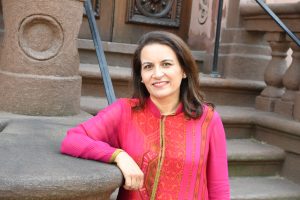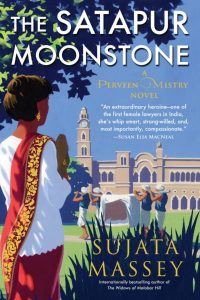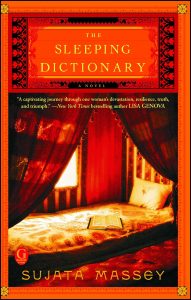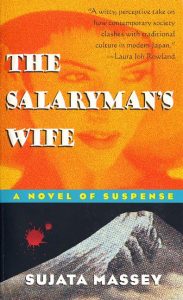Author Sujata Massey takes us behind the scenes of The Widows of Malabar Hill and her new historical mystery series set in India.
For her interview with Reading Group Choices, Sujata Massey speaks about the political and cultural climate of 1920s India, the issues confronting women then and now, and how she constructs a mystery…
Reading Group Choices: Perveen originally wishes to study literature, but her father wants her to study law — which later she embraces and realizes how valuable her contributions can be. Can you talk about that decision to originate the desire for law outside of Perveen herself?
 Sujata Massey: The accomplishments of children are something that many parents love to boast about—and progressive Parsi parents in turn of the century India were the same as everyone else. But instead of boasting about a daughter’s embroidery or cooking, a substantial group were proud to have a daughter be a school principal, or physician or lawyer. Such achievements put a family in a special rank. Also, a busy solicitor like Jamshedji Mistry longed for one of his children to work with him. Perveen was a better fit than his son.
Sujata Massey: The accomplishments of children are something that many parents love to boast about—and progressive Parsi parents in turn of the century India were the same as everyone else. But instead of boasting about a daughter’s embroidery or cooking, a substantial group were proud to have a daughter be a school principal, or physician or lawyer. Such achievements put a family in a special rank. Also, a busy solicitor like Jamshedji Mistry longed for one of his children to work with him. Perveen was a better fit than his son.
Perveen feels very independent when, at age eighteen, she rejects her father’s ideas and follow her heart into something unplanned. Surprisingly, her choice turns out to be disastrous, and she feels wistful of the reading and intellectual discussion she passed up in order to fry potatoes in her grumpy mother-in-law’s kitchen. Slowly, she comes to accept that her father’s original career plan for her aligns with her own strengths.
RGC: Ironically, being a woman allows Perveen access to interview each of the widows in The Widows of Malabar Hill, since they live in purdah, or seclusion from men. The same circumstance prompts her investigation in the second book, The Satapur Moonstone. The limitation that one religious practice places on women becomes the source of another woman’s power. Can you talk about how patriarchal systems might “backfire” in this way?
Sujata Massey: The practice of secluded women avoiding speaking with men outside the household could be interpreted very strictly, or just for show. In Perveen’s first adventure, she’s worried that three widows in a polygamous household are unable to leave their homes to get any kind of information about their finances, see their natal families, or educate their children as they would like. A male household guardian is blocking access to her father, who serves as the lawyer for the ladies’ deceased husband and the estate. Perveen knows that if a woman comes to the house, the household agent has no good excuse to avoid allowing her entry—so she manages to meet the women and counsel them on their rights.
Purdah is used slightly differently in the second Perveen book. Royal women of Muslim and Hindu religions were almost always living in a state of purdah to reinforce the exalted state of the royal line—and also protect them from assault, if invaders were to enter the palace. Two royal widows are able to avoid cooperating with the British by refusing male ICS officers entry to the palace. In British India, government officers were terrified of being accused of violating Indian women’s dignity, so they were unable to check on women and children who were rumored to be abused by corrupt family members.
 Similarly, if there was a legal case such as suspected theft or murder, Indian women could not be compelled to come to court to testify if they cited reasons of purdah. Because of this obstacle, the British courts employed convoluted strategies, such as sending a legal officer to the lady’s home with a notebook and having him record the testimony of someone who was either behind a screen or draped head to toe with a sheet. Sometimes the person under the sheet was an imposter, but the speaker could not be compelled to show her face, and the written testimony was presented in court. The more I think about it, an imposter hiding under a sheet would be quite a good character for a future Perveen book.
Similarly, if there was a legal case such as suspected theft or murder, Indian women could not be compelled to come to court to testify if they cited reasons of purdah. Because of this obstacle, the British courts employed convoluted strategies, such as sending a legal officer to the lady’s home with a notebook and having him record the testimony of someone who was either behind a screen or draped head to toe with a sheet. Sometimes the person under the sheet was an imposter, but the speaker could not be compelled to show her face, and the written testimony was presented in court. The more I think about it, an imposter hiding under a sheet would be quite a good character for a future Perveen book.
RGC: Perveen tells her British friend Alice, “We can still find the real India: it has so many different kinds of people and customs, you’ll never be bored.” In your experience, beneath the incredible diversity of language, religion, and culture, are there any qualities or traits that people across India share?
Sujata Massey: I’d say the vast majority of Indian people that I meet every time I travel for work and family reasons are friendly and confident people, secure in their identities and welcoming to newcomers. Although India has a long tradition of hospitality, I think this straight-talking, open style is a reflection of life after independence. Because Indians during the colonial years were constantly belittled and abused, I think that the relationships I have as an American coming into India would have happened very easily. Indians had to be helpful to the British; the exchange was based on fear.
Perveen wants things to be different for Alice. She includes her at home meals because Alice fervently wants to have really spicy food rather than mild Anglo-Indian fare. And Alice is eager to find a teaching job in the city so she can meet people outside of the colonial bubble. There’s no doubt that as the series continues, Alice will play an important role as a foreigner seeking to separate herself from the ways of her isolated, elite parents.
RGC: “It’s 1921. Your parents can’t force you into marriage.” Comments like these, though forward looking almost 100 years ago, still feel relevant today. In investigating the story of India’s first female lawyer, did the boundaries she cross give you a sense of progress since that time for women, or given the limitations that still exist, a lack of one?
Sujata Massey: Perveen has the misconception that the British didn’t have arranged marriages in the 1920s—they did arrange marriages for royalty, and it’s arguable that such a tradition went on into the 1980s through the union of Prince Charles and Lady Diana Spencer. Arranged marriages are still more common than not in India (and many other countries around the world).
 Today’s arranged marriages in India are often pre-approved introductions by families and matchmakers, and the young people are allowed to meet and decide if they wish to go forward. The expression I hear when people talk about their marriages is “love comes after marriage.” For most of my friends and relatives in such unions, that is true. And I also think of the meaning of marriage as being other things than fireworks in the bedroom and roses on the dining table. Good marriages can foster deep friendship without much romantic attraction, or serve as a harmonious exchange of services for financial security or social status.
Today’s arranged marriages in India are often pre-approved introductions by families and matchmakers, and the young people are allowed to meet and decide if they wish to go forward. The expression I hear when people talk about their marriages is “love comes after marriage.” For most of my friends and relatives in such unions, that is true. And I also think of the meaning of marriage as being other things than fireworks in the bedroom and roses on the dining table. Good marriages can foster deep friendship without much romantic attraction, or serve as a harmonious exchange of services for financial security or social status.
To see revealing examples about the link between tradition and modern marriage, you could watch an Indian dramatic series on Amazon called Made in Heaven. Even though the weddings take place among the wealthy of New Delhi, the series explores many age-old issues and reveals how young Indians are either trying to change things for themselves—or not. It shows the power of parents and others in controlling marriage, and the idea of marriage working as a kind of business contract.
RGC: The restricted quarters where the widows live mirror the isolation room that Perveen’s in-laws force her to inhabit during menstruation. Can you talk about how such parallels came together for you when writing the story?
Sujata Massey: Through both examples, I wanted to make the reader think hard about who, of the women in the book, is truly free. The idea of women living in one part of a house only—and being restricted socially—sounds horrific to most people. But the irony was, the same kind of treatment was going on in a slightly different way within one of the most progressive religious groups, the Parsis. So, when Perveen goes to interview the widows, she suddenly begins feeling confined and remembering her own weeks spent in a tiny, dark room. I also imagined what it would be like for a young girl, newly menstruating, to be put in such a place and not be allowed out—and for this trauma to play out month after month.
Menstrual seclusion was a tradition continued into the mid-twentieth century in orthodox families. Ostensibly, it was positioned as giving the woman a rest from her household duties. Some Parsis I’ve met have said their mothers considered the seclusion a peaceful time of rest. And in some homes the restriction was interpreted more liberally, with parents telling daughters to stay away from the kitchen during the time of the month.
When I was a younger writer, I would have been too shy to write about menstruation in a book that would be published for a general audience of both men and women. I’ve found out at readings that this section has affected many readers who are are upset about injustice against women.
The Widows of Malabar Hill also includes chapters detailing treatment of venereal disease and women’s health. Perveen’s mother-in-law is very involved in her medical treatment—there is no privacy for a young wife with a husband who’s transmitted an STD to her. That lack of privacy reminds me of how much we could stand to lose if laws are approved that deny women privacy and decision-making about our bodies. There’s a situation now in a southern state of the United States where legislators want to track teenagers’ menstrual cycles to make sure they haven’t had abortions.
 RGC: During Perveen’s series of interviews with the widows, and her conversations in the Kolhapur Agency’s outpost and palaces in The Satapur Moonstone, there’s a delightful feel of the fair play mystery at its best. Details are revealed, and differing stories raise questions and become key to understanding later motives. Can you talk about the process of building a solvable mystery? Did your background as a journalist for The Baltimore Evening Sun contribute to how you handled these conversations?
RGC: During Perveen’s series of interviews with the widows, and her conversations in the Kolhapur Agency’s outpost and palaces in The Satapur Moonstone, there’s a delightful feel of the fair play mystery at its best. Details are revealed, and differing stories raise questions and become key to understanding later motives. Can you talk about the process of building a solvable mystery? Did your background as a journalist for The Baltimore Evening Sun contribute to how you handled these conversations?
Sujata Massey: Thank you so much for noting the historical narrative construction. I want a book set in 1921 to read like one written at the time. That sometimes means assembling an entertaining group of strangers at a dinner party, as I did at Colin Sandringham’s Circuit House in Satapur. Throughout this book, there are lots of interviews between Perveen and people who are British, Indian and Anglo-Indian; peasant, officer, and royal, including a young prince and princess.
Such interviews would occur in real life for a legal investigator trying to find the best solution for a child’s path. I never had to interview as many people for one of my newspaper feature stories, thank goodness. I could certainly not have sorted out all the voices and themes for a concise article running in the next day’s paper.
That book took me longer than a year to write, which is true of all the Perveen novels. And then the editing was quite a few months of back-and-forth. During the editing stage, there’s time to look at all these conversations and make them much more than dialog—add in the gestures, expressions, aromas and vocal tones that bring the scene to life. Which is something I could not easily do in journalism, because I was schooled not to show opinion, just facts. When I began writing mysteries, it was like crossing a Rubicon to learn to characterize people beyond their dialog and physical appearance.
RGC: The Satapur Moonstone engages the role of politics more directly, as Perveen acts in service to the British government to mediate a provincial dispute. The colonial system is complex, and Perveen must balance her professional role with her support of Gandhi and Indian independence. What did the politics of the era allow you to learn about the evolution of Perveen’s character from the first book to the second?
 Sujata Massey: In the arc of this series, I want to explore what it was like for the group of Indians who felt caught between a desire for self-determination and for security. Perveen’s family success arose because they literally built Bombay from the ground up for the East India Company. I have a similar situation in my own background—not that I am Parsi, but I do have Bengali Hindu ancestors who were landowners and gave up a village to the East India Company after being pressured by a local nawab. That village later grew into Calcutta. The elites worked with the colonials in order to not to have their land forcibly grabbed and lose status in a changing subcontinent.
Sujata Massey: In the arc of this series, I want to explore what it was like for the group of Indians who felt caught between a desire for self-determination and for security. Perveen’s family success arose because they literally built Bombay from the ground up for the East India Company. I have a similar situation in my own background—not that I am Parsi, but I do have Bengali Hindu ancestors who were landowners and gave up a village to the East India Company after being pressured by a local nawab. That village later grew into Calcutta. The elites worked with the colonials in order to not to have their land forcibly grabbed and lose status in a changing subcontinent.
India’s resistance movement, which began in the 1800s, began first with intellectuals and then spread to the working classes. By the early twentieth century, many women in India were involved in the freedom movement, attending political meetings, donating money and jewelry to the cause, and protesting in the street.
Perveen’s intelligence—plus her exposure to liberal politics inside England—lead her to decide independence is the right thing for India. In The Widows of Malabar Hill, she is frightened, but she still refuses a request from Alice’s high-ranking father to assist by fingerprinting women in purdah.
The following book, The Satapur Moonstone, has Sir David asking again for Perveen’s assistance. The government will pay Perveen to travel to a palace and interview the maharanis in purdah so they will know where the young maharaja should be allowed to be educated. She accepts the mission, seeing the prospect of more business with other royal women who have not been heard. Yet at the same time, she knows that the answer the British are seeking is the one that would foster continued royal acceptance of British rule. It’s tricky, but Perveen helps engineer a power shift so the kingdom’s future is headed in a way the Kolhapur Agency doesn’t understand.
RGC: You know better than anyone how cultural and religious norms dictate and influence plot. Can you talk about changing gears from your series of books set in Japan, featuring Rei Shimura, to the first two books in the Perveen Mistry series? How might Perveen function in Japan, and Rei in India? (If such a question can be answered!)
Sujata Massey: I must say it was a lot faster to plot and write books set in the present day—the Rei Shimura series. The simplest reason is I was writing a woman close in age to me who was also an American. I used my own voice for Rei, and the story was even told in first person. Yet all the time I was writing that series, I was slipping in bits of Asian history into the plot because that was what fascinated me. Because Rei has an art history background, I know she would have been ecstatic to time-travel back to the 1920s, and I think she would have made a move on Colin Sandringham!
Perveen is harder to write—but quite delightful. When I consider what she would say to a client or her father, I remember that she is more restricted than a modern woman. She has not yet disobeyed her father; I imagine it may happen sometime, but that would be a very big crisis, and it might result in him not trusting her to continue in the family firm.
 I write this series using a third person voice, so I avoid accidentally speaking in a modern, casual way. For Perveen’s voice to ring true, I have learned much from Indians of a certain age. Indian English still has whiffs of old-fashioned British English; and I was born in Sussex, England, and I grew up reading historic British children’s books for many years, which added to my affection for such words as “torch” instead of “flashlight” and expressions like “don’t lets” instead of “let’s not.”
I write this series using a third person voice, so I avoid accidentally speaking in a modern, casual way. For Perveen’s voice to ring true, I have learned much from Indians of a certain age. Indian English still has whiffs of old-fashioned British English; and I was born in Sussex, England, and I grew up reading historic British children’s books for many years, which added to my affection for such words as “torch” instead of “flashlight” and expressions like “don’t lets” instead of “let’s not.”
When I think about sending Perveen to Japan, I know she would be quite interested because in those days, Japan was a refuge for Indian freedom fighters. The Japanese also wove very fine silk saris that were exported to India. She would have found her place there quickly.
RGC: From what’s on the table to the tuck of a sari, from the taste of a pastry to the mud of provincial roads, both novels immerse readers in 1920s Bombay and Satapur. As with a careful recipe, how do you know when you have added just enough atmospheric spice?
Sujata Massey: I’ve got a hoarder’s tendency to collect details about places and things. The challenge is not overdoing it, which means big decisions on tiny details. When I’ve written a paragraph about some historical aspect of Bombay that I find fascinating but that doesn’t advance understanding of the characters or the story, it may not be worth including.
Just yesterday I spent almost a half-hour mulling over what to include in two paragraphs describing the architecture of the Asiatic Society of Bombay. When I began to focus on life details of its architect, it was too much. I only needed to say it’s a neo-classical building with a giant wide flight of stairs—and there have always been civic meetings held there, and the Society owns valuable antiquities as well as thousands of books and newspapers for its members to peruse. Truly, the most important thing to share about the Asiatic Society is how the experience of researching in its rooms helps Perveen draw connections from the past to a modern murder case.
How much detail to share is guided by the pace of the book. And when I enter the rigorous editing phase, I count on my editor to alert me if there isn’t enough detail about something. Interestingly, that concern of “too much” or “too little” doesn’t usually occur with locations, clothing, or food. Where I am called to give more detail is usually in sharing a character’s emotions. That’s where the heart of a story is, anyway.
Visit Sujata Massey’s website for more information about her mysteries, and discover other great author interviews on the Reading Group Choices blog!
